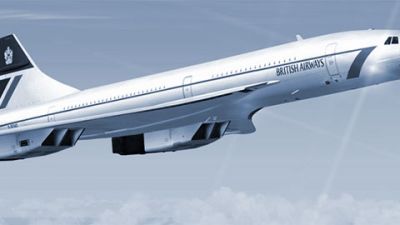
Concorde X Review
This meticulously crafted Concorde X expansion unites in-depth avionics, fluid supersonic handling, and an intuitive flight deck interface…
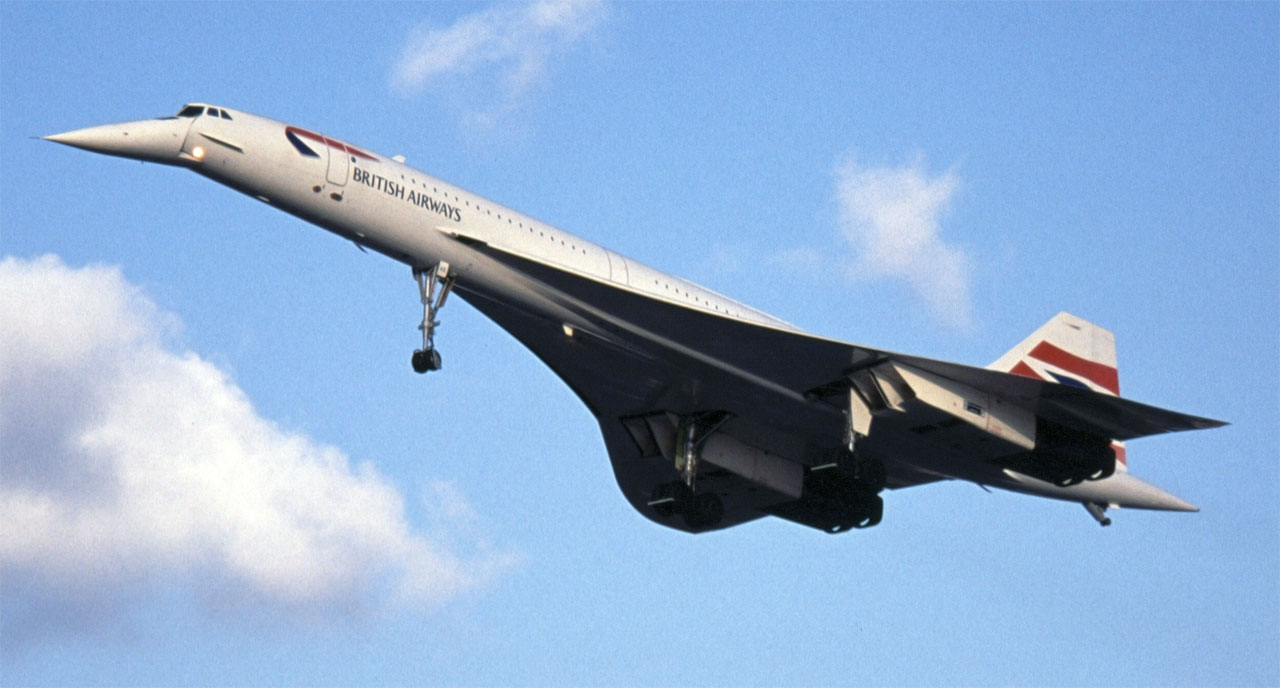
Boom! BOOM! That was the incredible double sonic boom of the majestic Concorde supersonic aircraft breaking the sound barrier. If it came in low as you watched in awe, the noise would make your bones rattle. The Concorde was perhaps the sexiest, most exciting airplane in the history of aviation. It was a joint venture between British Airways and Air France that had its maiden voyage in 1969 but began commercial service in 1976. After a crash in 2000 in Paris, traveler interest in the plane began to diminish and in April of 2003, both airlines announced they would discontinue service.
Table of contents
That was a far cry from its beginnings. When it first began regular service, the Concorde was the rock star of aviation. Royalty and celebrities were common among the famous clientele. On any given flight you might see Sting or Mick Jagger sitting next to the Queen of Jordan. Regular people clamored to take a flight. There were reports of people mortgaging their home just to be able to afford the expensive tickets.
It was worth the price. If you flew from New York to Paris on a regular plane you were on board for over eight hours. The Concorde made the same trip in only 3.5 hours. By the time your slowpoke brethren landed at de Gaulle airport, you were finishing your Mussels Mariniere and a second glass of Sauvignon Blanc along the Seine.

British Airways Concorde with landing gear down.
The boom was a result of breaking the speed of sound. Sound travels at around 330 meters per second. As the Concorde ripped through the air, it pushed air out of the way in the form of a cone-shaped pressure wave from the tip of the nose. The cone surrounds the plane and radiates outward. As this shock wave emanates the sound is heard as a sonic boom.
There was a double boom because there were separate booms related to the nose and the tail. From a distance, they blend together into one huge sound. Up close you can hear the separate booms. You can actually see them as well. As the air gets pushed out of the way, it can’t get out of the way quick enough and the pressure wave becomes visible around the rear portion of the plane.
Back in the 1950s four countries were considering creating supersonic aircraft: The United States, the Soviet Union, France, and Britain. Due to the significant costs involved, Britain realized the need for international co-operation on a joint venture. They approached the others but only France showed real enthusiasm. They set up a consortium and opened for business in the early ’60s. Immediately they booked orders from a wide variety of airlines including Japan Airlines, United Airlines, Air Canada and Qantas.
The first test flight left Toulouse, France in early 1969. In mid-summer, the Concorde was on display at the Paris Air Show. In 1973, it made its first landings in the U.S., including the Dallas/Ft. Worth Regional Airport.
The Concorde is heavily influenced by the British Avro Vulcan strategic bomber, another delta wing airplane. The delta wing has the advantage that the leading edge of the wing will not be affected by the shock wave as the plane enters into supersonic speed. The airplane can travel faster than the speed of sound, but the lift on the wing is less than the speed of sound.
In addition, the delta shape is inherently much stronger than traditional wing design, important at supersonic speeds. At the same time, the skin is thin and inexpensive to replace and repair. The delta shape also provides maximum wing area with a correspondingly low load on the wings themselves.
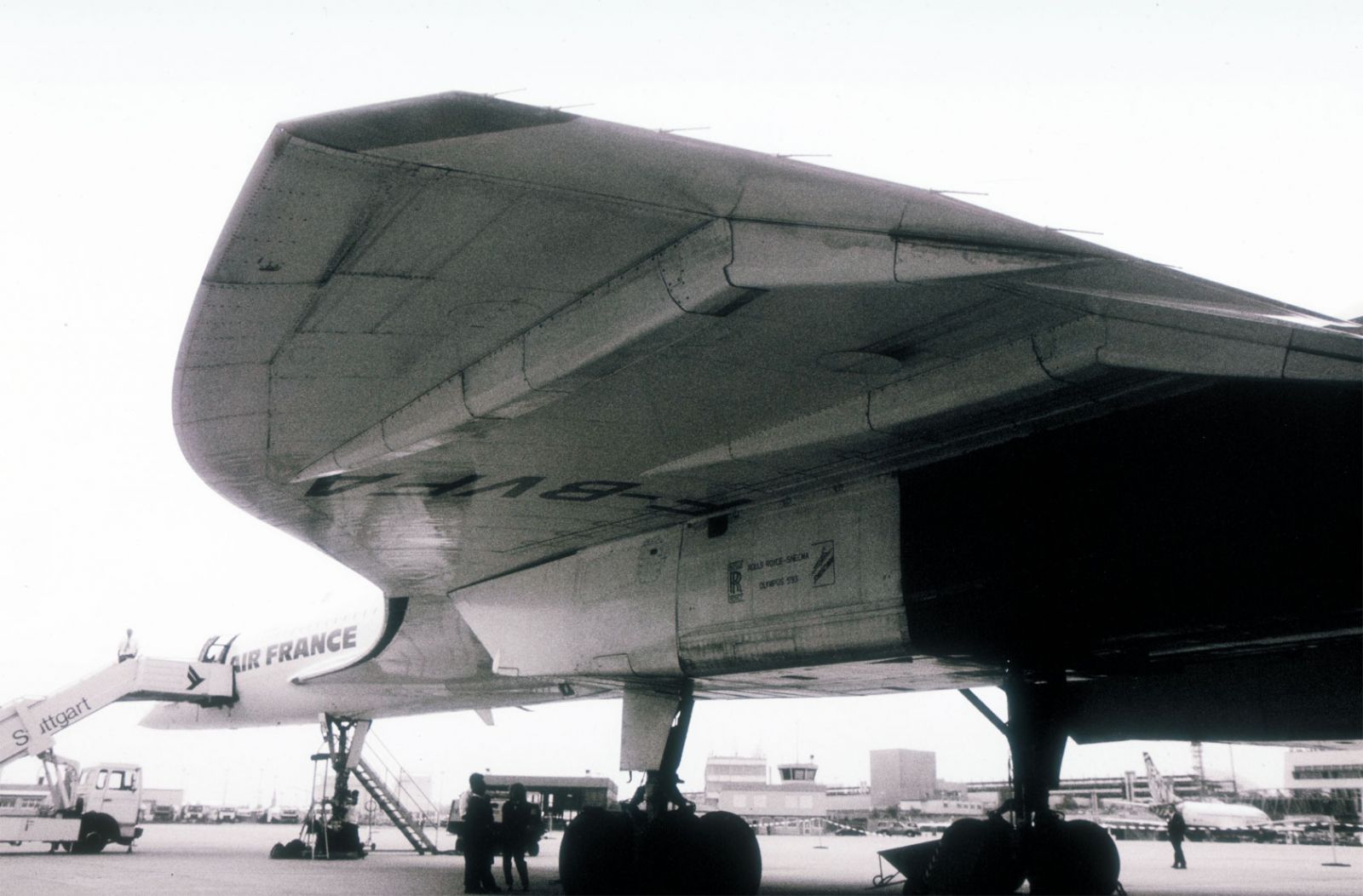
Image showing Concorde's wing profile - in black and white.
Delta wings also generate a vortex from the leading edge of the wing as the angle of attack rises. This creates a high stall angle which would cripple a normal plane at low speeds. The downside is that maneuverability is severely compromised. But the Concorde was never designed for mid-air gun battles.
While turbofan engines were initially considered, turbojets were selected for the Concorde. The Rolls Royce/Snecma Olympus 593 was voted as the winning engine—it was the powerplant used in the Avro Vulcan. Turbofans were rejected due to the excessive drag they would create.
Engine failure at supersonic speeds would seem to be a fatal situation. For a regular plane, when the engine fails it not only is no longer helping propel the aircraft forward, it creates drag. The plane will then bank and lean in the direction of the failed engine. In contrast, a supersonic jet deflects air around the engine, adding lift, reducing drag considerably. The Concorde aircrews regularly trained for possible engine failure.
You can imagine the Concorde’s structure is under incredible pressure at such high speeds. This is especially true during banking and turning. Engineers helped alleviate those stresses with active ratio changes in the elevons, which would change at different air speeds. The innermost elevons, attached to the wings, are the only ones active at supersonic speeds.
The Concorde experienced wide ranges in temperature during a flight—it cooled rapidly as it rose in altitude; then it heated up considerably once entering supersonic speeds, only to go through the reverse as it descended. Significant metallurgical testing was conducted to determine the best metal for these large changes in temperature.
In fact, as it traveled it heated up so much it stretched more than a foot in length. Often space would open between the bulkhead and the area for the flight engineer. On several of the Concorde’s final trips, flight engineers placed their hats in this gap, where they were permanently clamped as the plane cooled and contracted to normal size.
Supersonic speed is great, but how do you stop all that energy safely? Concorde engineers employed the first carbon-based anti-skid brakes ever used on an airliner. They were designed to be able to stop a 185 ton Concorde within one mile from an initial speed of 190 mph. At that speed, things get a little hot—the brakes heat up to over 300 degrees Celsius and need several hours to cool down.
Another challenge with a delta wing supersonic aircraft is the undercarriage. Since the Concorde does not generate lift like a typical plane, it places much more stress on the rear undercarriage. The early models were redesigned and a small set of wheels were added at the rear. This keeps the tail from hitting the ground on steep lift-offs. In addition, the rear wheels were made to be able to retract inside the undercarriage before swinging up and closed.
Perhaps the most iconic design feature of the Concorde is its distinctive droop nose. Because delta wing aircraft have such a steep angle of attack, it can be difficult for the pilot to see over the nose. The nose is engineered to allow it to change position depending on the stage of flight. For taxiing and takeoffs, the nose was lowered 5 degrees. Once in the air, it was raised again. It was then lowered 12.5 degrees for landings. Once on the ground, the flight crew brought the nose back up to the 5-degree position to lessen the possibility of damage.
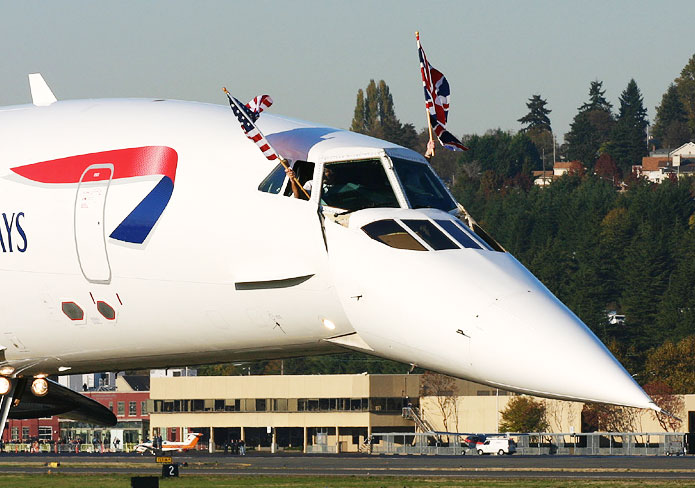
Concorde's nose in its down position used when in slow flight.
Not only was the Concorde faster than regular planes, it flew higher. As it traversed the Atlantic, it enjoyed its own cruising lane at around 55,000 feet. It was cleared for special air blocks allowing it to slowly climb from 40,000 feet to cruising level without interference. As it landed, the drag on the plane was reversed—raising the nose would make the sink rate rise in response. When the wheels touched the ground, it was traveling over 170 miles per hour.
The Concorde’s first scheduled flights were London-Bahrain and Paris-Rio. The U.S. Congress had banned the plane in the U.S. over concern of the sonic boom. Finally, the Secretary of Transportation allowed it to land in Washington, D.C. --New York soon followed despite continuing controversy by vocal opposition who complained that the noise was too much.
Advocates were able to show that Air Force One was actually louder than the Concorde. Regular flights between New York and Paris began in late 1977.
Creative partnerships flourished in this time period. For example, Braniff Airways leased several Concorde’s from both British Airways and France. They used their own crews to fly a subsonic route between Dallas and Washington at which point British and French crews flew them supersonically over the Pacific.
As a new decade dawned in 1980, the future for the Concorde did not look so bright. Britain was losing tons of cash. The director of British Airways considered selling the whole fleet. Instead, they raised prices and eventually turned a profit. Prospects looked better and regular routes were flown through the 1980s. Charter flights were consistently booked for multiple European hotspots.
All this positive momentum ended on July 25, 2000. On that fateful day, Air France Flight 4590 crashed in Gonesse, France, with all 100 passengers and 9 flight crew members perishing. On the ground, four more people died. Although it was the only fatal accident for the Concorde, it was the beginning of the end. Enthusiasm for the aircraft waned.
The cause of the accident was an incredible stroke of bad luck. A piece of titanium fell off a DC-10 that had just taken off minutes before the Concorde. The metal punctured a tire which exploded. A piece of that tire hit the fuel tank which caused a shock which busted open a fuel valve in the wing. Fuel began to stream out the back of the plane—suddenly a spark from wires exposed by the tire exploding ignited the fuel.
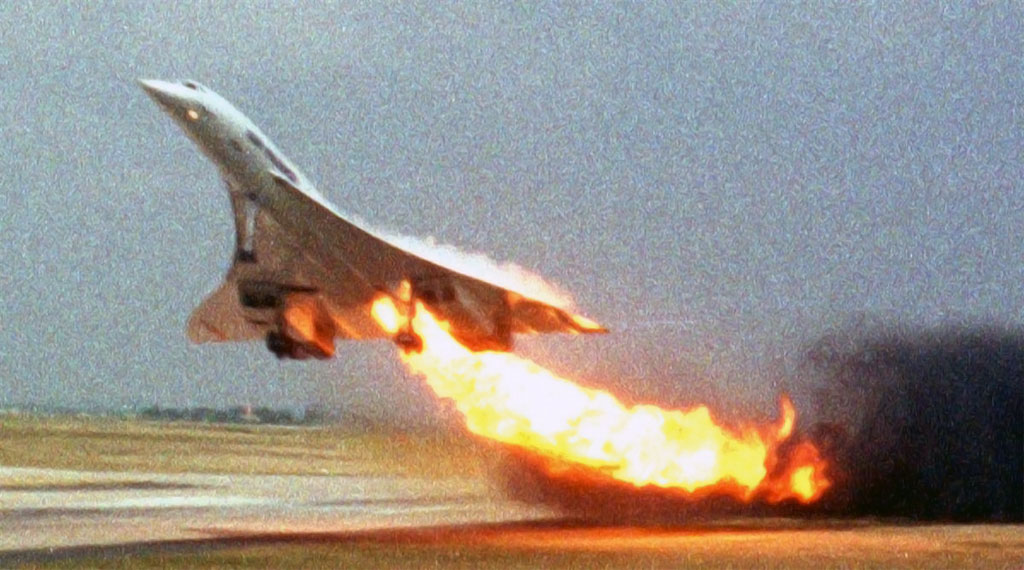
Image shows flames coming out of the wing of Concorde as it takes-off from Paris before it crashes.
The crew shut down Engine 2 but Engine 1 did not have enough juice to get the plane off the ground properly. It rolled into a leftward lean and then crashed violently into the Hotelissimo Hotel in Gonesse. Up to that day, the Concorde had one of the safest flight records in the industry. Several new safety features were introduced including Kevlar lining for the fuel tanks and improved tires.
British Airways staged the first flight after the crash with passengers. They flew from London to New York with a plane full of BA employees. They landed safely and without incidence on September 11, 2001, shortly before the terrorist attacks in New York, Washington, and Pennsylvania.
In 2003, both British Airways and Air France announced it was the end of the line—they were going to end the Concorde program at the end of the year. The struggling economy, the Paris crash, and sky-rocketing maintenance costs all created the perfect storm that did in the Concorde.
British businessman and impresario Richard Branson offered to step in and take the whole fleet over for the price of 1 pound and promised to operate the planes for years into the future. He never got the chance. Skeptics believe that high-level politics played a role in the demise of the Concorde, possibly from fears over the financial risk of lawsuits if there was another crash.
It could be simple economics. Airbus was reluctant to continue servicing the airframes. And the airlines determined they made just as much or more money by expanding first class service on their subsonic flights.
If anything, no one can deny that the Concorde was get-up-and-go fast. The fastest transatlantic record was set in 1996: 2 hours, 52 minutes and 59 seconds. You and I spend more time than that walking between terminals at Chicago O’Hare. There were other records set including both the “Westbound Around the World” and “Eastbound Around the World” air speed records. One chartered circumnavigation of the globe took only 32 hours and 49 minutes taking off and landing in Lisbon with 6 stops including Acapulco and Bahrain.
Despite the ending of the Concorde service, people continue to love the plane for its speed and modern design. With its dual citizenship, the Concorde is everyone’s hometown hero. In Britain, they think of it as their own and the same is true in France.
At an auction in 2003 of Concorde parts and memorabilia in Paris, 1300 people went well over the expected bids. One French Concorde is on display in a museum in Germany alongside other famous aircraft. British Airways has a model on display in Barbados.
Bohman's auctioneers held an auction in London of Concorde artifacts, including one of the famous nose cones. Again, bidding outdid expectations and the bulk of the earnings were given to charity. Concorde’s are on display at the Brooklands Museum in Surrey as well as Le Bourget Air and Space Museum in Paris.
Rumors of a Concorde comeback have surfaced at various times and other firms are developing their own projects. Right after the Concorde program shut down, the parent company of Airbus announced possible partnerships with Japanese firms to produce a bigger and faster supersonic champion. Two years later, the Japanese Aerospace Exploration Agency began testing an aircraft that could travel at Mach 2 while carrying over 300 passengers.
Similarly, a British company called Reaction Engines started research in 2008 exploring a hydrogen-powered plane that could carry 300 passengers traveling Mach 5. That is unheard of speed--you could travel 10,400 miles in about just under 5 hours! In May of that year, Aerion Corporation took billion dollar pre-orders for its own Aerion SBJ supersonic jet.
Another company named Supersonic Aerospace International developed a small, 12 passenger plane called the Quiet Supersonic Transport that reportedly could travel at Mach 1.6 with only a mere fraction of the noise of the Concorde. There have also been discussions between France and Sweden for a possible joint supersonic effort.
It stirs the soul to think of a possible rebirth of a legend. However, the sheer number of rumors and subsequent lack of any real airplanes douses that fire quickly. Like Elvis Presley, the Concorde is a legend from a different time.
While the Concorde evokes images of wealthy jet-setters, it took strides to include the rest of us. Special flights were often arranged that were within the means of middle-class flyers.
As one YouTube commenter stated,
“…she made flight sexy and beautiful at the same time without even having to try hard…a work of art for all time, there will never be one more loved than the Concorde anytime soon.”
For both ordinary people and dedicated aviation enthusiasts, Concorde was the greatest plane ever built and the most beautiful aircraft ever to grace the skies.

The legendary Concorde making a landing in London. The image illustrates the graceful beauty of this amazing, one-of-a-kind aircraft.
You can also download and install this legendary aircraft for your copy of Microsoft Flight Simulator X. You can get your hands on the FSX version here.
Upgrade Microsoft Flight Simulator, FSX, P3D & X-Plane in minutes with our curated file library packed with aircraft, scenery, liveries, and utilities.
Ready to upgrade your hangar?
Browse the free file library
3 comments
Leave a ResponseThe content of the comments below are entirely the opinions of the individual posting the comment and do not always reflect the views of Fly Away Simulation. We moderate all comments manually before they are approved.
On my sixtieth birthday, my family bought me a charter flight on CONCORDE from Leeds Bradford airport. When I tell my friends about this being the best birthday present any one could wish for they usually ask "where did fly to ?" This was August 1999. Where can I get this information? If I have contacted you in error I m sorry so please don't reply. Granville Canty.
I was a Concorde pilot and i must say it was great flying it as it was a very large technological advancement and one can only wonder how much this country has stepped backwards (UK).
'the plane time never caught up with' Dr S Keeley 2001
I used to work for Cunard in NY and had the privilege of flying BA Concorde (G-BOAF) on a charter flight to Colombus, Ohio back in the 90s. One of the best experiences of my life. Even subsonic, a completely differnet flight. To feel the power of those afterburners leaving JFK was amazing. Best looking "bird" in the sky, it's a shame she's not in the sky anymore, where she belongs!